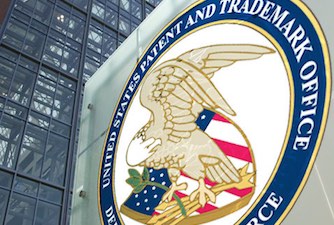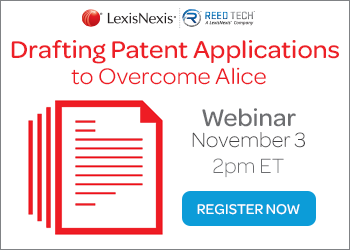 Earlier today the United States Patent and Trademark Office issued a new memorandum to patent examiners on recent software patent eligibility decisions from the Federal Circuit. The memo sent to the patent examining corps from Robert Bahr, who is Deputy Commissioner for Patent Examination Policy, explains that this most recent memorandum provides examiners with discussion of McRo, Inc. v. Bandai Namco Games America and BASCOM Global Internet Services v. AT&T Mobility. [1]
Earlier today the United States Patent and Trademark Office issued a new memorandum to patent examiners on recent software patent eligibility decisions from the Federal Circuit. The memo sent to the patent examining corps from Robert Bahr, who is Deputy Commissioner for Patent Examination Policy, explains that this most recent memorandum provides examiners with discussion of McRo, Inc. v. Bandai Namco Games America and BASCOM Global Internet Services v. AT&T Mobility. [1]
Bahr acknowledges in the memo that the Federal Circuit yesterday issued another precedential decision in Amdocs (Israel) Ltd. v. Openet Telecom, which will be discussed in forthcoming subject matter eligibility guidance. [2]
With respect to McRo, Bahr instructed examiners as follows:
Examiners should consider the claim as a whole under Step 2A of the USPTO’s SME guidance, and should not overgeneralize the claim or simply it into its “gist” or core principles, when identifying a concept as a judicial exception…
An “improvement in computer-related technology” is not limited to improvement is operation of a computer or computer network per se, but may also be claimed as a set of “rules” (basically mathematical relationships) that improve computer-related technology by allowing computer performance of a function not previously performable by a computer.
An indication that a claim is directed to an improvement in computer-related technology may include—
(1) a teaching in the specification about how the claimed invention improves a computer or other technology…
(2) a particular solution to a problem or a particular way to achieve a desired outcome defined by the claimed invention, as opposed to merely claiming the idea of a solution or outcome…
With respect to BASCOM, Bahr instructed examiners as follows:
In Step 2B of the USPTO’s SME guidance, examiners should consider the additional elements in combination, as well as individually, when determining whether a claim as a whole amounts to significantly more, as this may be found in the non-conventional and non-generic arrangement of known, conventional elements…
(emphasis in the original).
Bahr also goes beyond McRo and BASCOM to address the issue of preemption, which has come up in several recent decisions. Bahr explains that this issue will be further addressed in forthcoming guidance, but points out that while at times the lack of preemption has been used to confirm a patent eligibility finding, such as in Rapid Litigation Management v. CellzDirect, there are other decisions that did not consider the absence of preemption. Therefore, examiners have been instructed as follows:
Examiners should continue to use the Mayo/Alice framework… to resolve questions of preemption. If applicant argues that a claim does not preempt all applications of the exception, an examiner should reconsider in Step 2A of the eligibility analysis whether the claim is directed to an improvement in computer-related technology or a specific way of achieving a desired outcome or end result… If an examiner still determines that the claim is directed to a judicial exception, the examiner should then reconsider in Step 2B of the eligibility analysis whether the additional elements in combination (as well as individually) are more than the non-conventional and non-generic arrangement of known, conventional elements.
(emphasis in the original).
 Finally, Bahr notices what so many of the rest of us in the industry have noticed, which is an increasing reliance on non-precedential dispositions by the Federal Circuit. He cautions patent examiners about relying on or even citing non-precedential decisions of the Federal Circuit “unless the facts of the application under examination uniquely match the facts at issue in the non-precedential decision.”
Finally, Bahr notices what so many of the rest of us in the industry have noticed, which is an increasing reliance on non-precedential dispositions by the Federal Circuit. He cautions patent examiners about relying on or even citing non-precedential decisions of the Federal Circuit “unless the facts of the application under examination uniquely match the facts at issue in the non-precedential decision.”
For those interested in this topic, I will be hosting a webinar on drafting patent applications to overcome Alice on Thursday, November 3, 2016 at 2pm ET. I will address this new Office memorandum, as well as all the latest Federal Circuit cases, including those issued over the summer as well as Amdocs, which issued yesterday. CLICK HERE to register.
_______________
[1] For my analysis of Mcro please see Federal Circuit says lip synchronization not abstract. For my analysis of BASCOM please see CAFC says software patent eligible again.
[2] For analysis of Amdocs please see Software claims patent-eligible because they recite a technological solution to a technological problem.

![[IPWatchdog Logo]](https://ipwatchdog.com/wp-content/themes/IPWatchdog%20-%202023/assets/images/temp/logo-small@2x.png)

![[Advertisement]](https://ipwatchdog.com/wp-content/uploads/2024/04/UnitedLex-May-2-2024-sidebar-700x500-1.jpg)
![[Advertisement]](https://ipwatchdog.com/wp-content/uploads/2024/05/Quartz-IP-May-9-2024-sidebar-700x500-1.jpg)
![[Advertisement]](https://ipwatchdog.com/wp-content/uploads/2024/04/Patent-Litigation-Masters-2024-sidebar-700x500-1.jpg)

![[Advertisement]](https://ipwatchdog.com/wp-content/uploads/2021/12/WEBINAR-336-x-280-px.png)
![[Advertisement]](https://ipwatchdog.com/wp-content/uploads/2021/12/2021-Patent-Practice-on-Demand-recorded-Feb-2021-336-x-280.jpg)
![[Advertisement]](https://ipwatchdog.com/wp-content/uploads/2021/12/Ad-4-The-Invent-Patent-System™.png)







Join the Discussion
11 comments so far.
B
November 5, 2016 08:23 pmStep back, yes, and the CAFC is not allowed to affirm on an alternative basis. Even failure to recite law is sufficient to reverse
Independent Inventor
November 5, 2016 08:02 pmGene (or anyone) — the CAFC is now showing Amdocs as a “revised” opinion on the CAFC website.
Anyone find what the revision(s) is/are? Anything substantive?
step back
November 4, 2016 04:26 pmB @6
Aren’t conclusions not based on evidence inherently arbitrary, capricious and thus in violation of 5 USC section 706?
Mark Nowotarski
November 4, 2016 02:09 pmHigh B. My email is [email protected]
B
November 3, 2016 09:32 pmAll I can think of is that the Panel forgot about Dickenson v. Zurko and in re Sang-Su Lee. Send me your email address and I send you a copy of the RFR
B
November 3, 2016 09:27 pmMark, I’m stating that an Examiner in 3689, backed by everyone’s favorite SPE, made it clear to me by stating “No evidence is necessary” in an office action (and orally) to prove that a particular activity is a “fundamental business practice.” Simple conclusion was enough. I have not seen a PTAB decision that reversed an Examiner for lack of evidence – although I’ve not looked in 6 weeks. I’m presently dealing with an RFR in front of the CAFC to recognize that evidence is necessary. Last thing I want to do is go to the SCOTUS given they don’t want to deal with the fallout of Alice. That said, I don’t know how to address 101 Alice rejections if all that is necessary is a conclusory assertion.
Mark Nowotarski
November 3, 2016 06:34 pmB regarding “3689” taking a position, can you be more specific? Are you talking about an examiner’s assertion in an office action or something more formal? Feel free to send me an email if it shouldn’t be discussed here.
B
November 3, 2016 03:36 pmDear Gene,
Enjoyed your webinar. FYI, Art Unit 3689 has taken the position (based on the PTO’s internal guidelines) that no evidence is necessary to declare that something is well-known, routine and conventional under Alice Corp. This point about an evidentiary requirement when making factual assertions under Alice Corp. was recently argued in front of Reyna, Taranto and Hughs.
Gene Quinn
November 3, 2016 03:10 pmMike-
I’d like to say it was deep insight, or even Freudian, but for some reason spell check hates the words precedential and nonprecedential, particularly in Safari on WordPress.
Will fix.
-Gene
mike
November 3, 2016 12:36 pmI can’t decide whether “the Federal Circuit yesterday issued another presidential decision in Amdocs (Israel) Ltd. v. Openet Telecom” represents deep insight into the politics of Federal Circuit patent jurisprudence or merely a Freudian slip…
Hmm
November 2, 2016 11:10 pmInteresting that the PTO used “gist” in quotations, as the seemingly quoted text relates to section 103 analysis. Are we finally moving towards defining an “abstract idea” or is this only playing lip service to the 101 case law relating to considering claim limitations in combination.